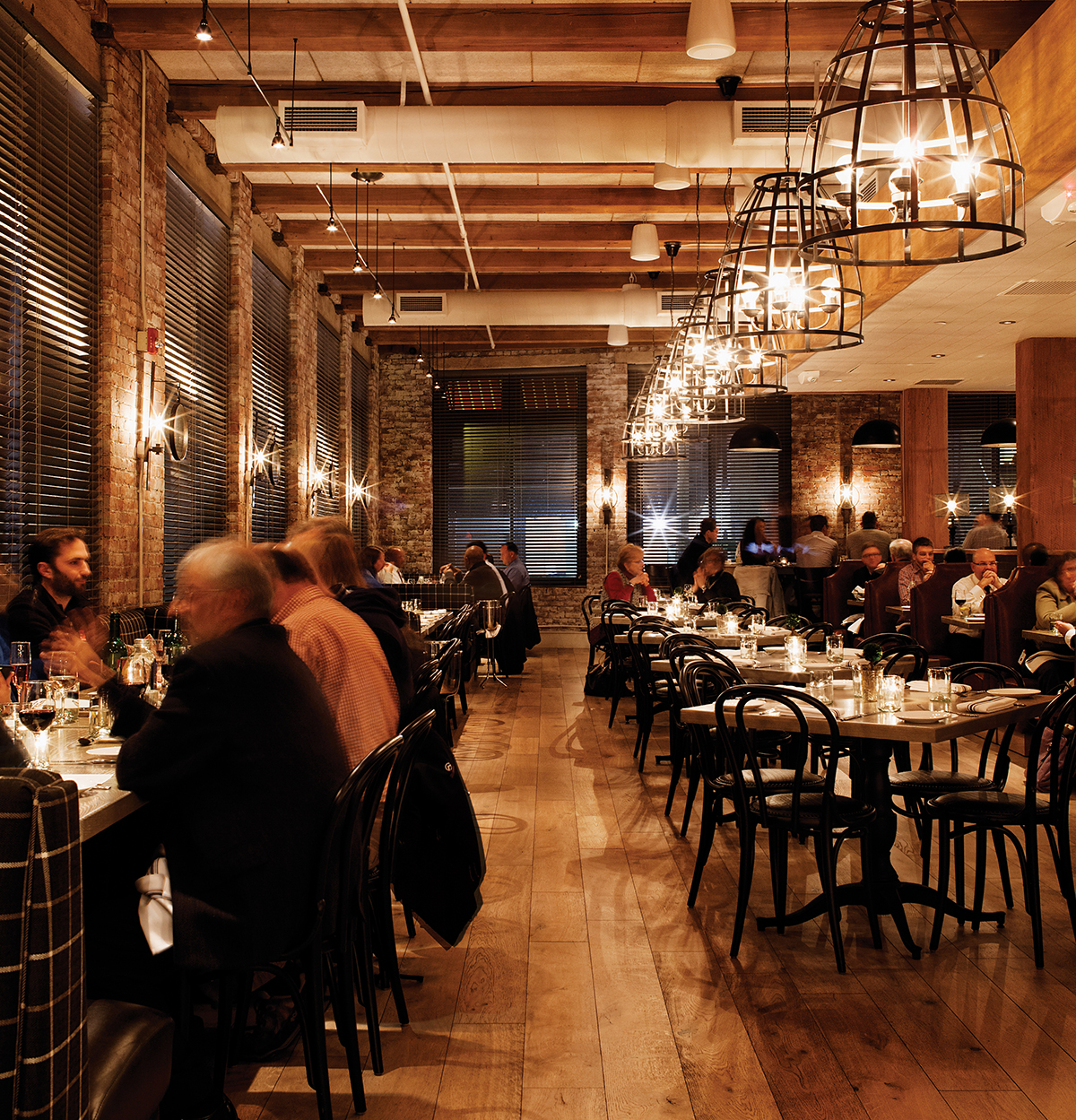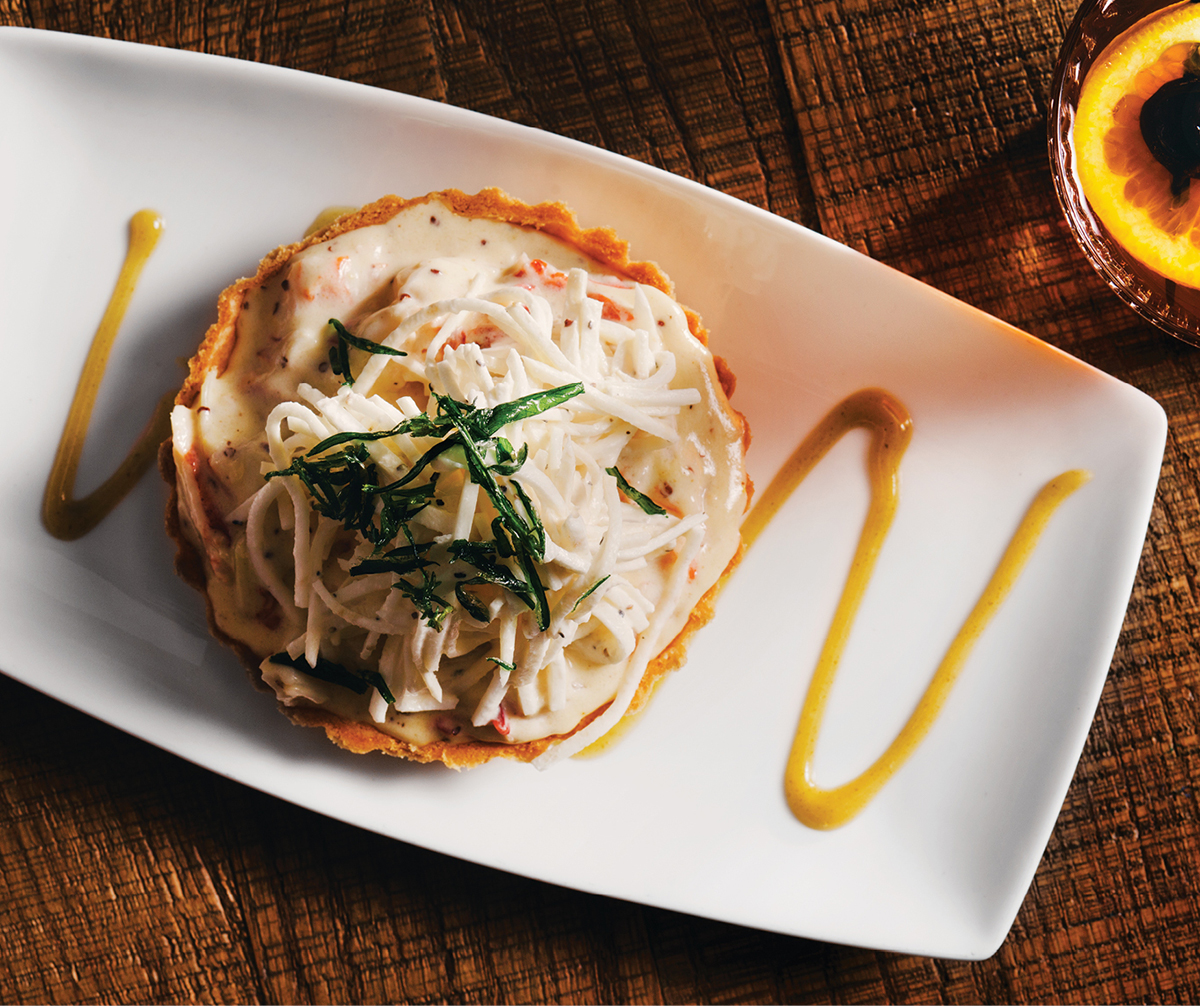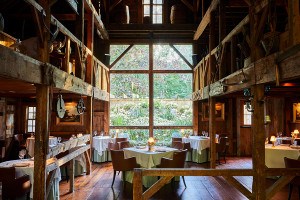Restaurant Review: Bastille Kitchen in Fort Point

The vast, well-appointed dining room at Bastille Kitchen; Photograph by Adam Detour.
By what business model can this restaurant succeed? That’s what I kept asking myself while dining at Bastille Kitchen, impresario Seth Greenberg’s vast new brasserie in Fort Point. Yes, most restaurants in this area that occupy sweeping, industrial spaces seem to be succeeding: Tavern Road, chiefly for its bar and floor-to-ceiling windows that open to Congress Street; Menton, the utterly luxe closed-curtain, above-the-street exception; the terrifically stylish Row 34. But over on Melcher Street, Bastille Kitchen’s main dining room is on the second floor, removed from the street traffic although near Ming Tsai’s very crowded Blue Dragon. With a staggering 300 seats spread across two floors, its projected P & L report must have anticipated a lot of diners churning through, night after night.
One way to attract a crowd: Use the décor to establish a scene, which is what Greenberg does best. He’s confidently employed that approach to create places that lure the well-off, as demonstrated by the Ames Hotel and Mistral—the latter a restaurant where he and his original partner, Jamie Mammano, have for years played pied pipers for well-heeled suburbanites. At Bastille Kitchen, wide-board floors seem to go on for a full block, and newly built beams are exposed to give the place a rustic look. It’s all dimly illuminated by caged chandeliers and coach-style lanterns hung on the exposed-brick walls. (There’s also a smaller, ski-lodge-inspired downstairs dining room and bar called the “Chalet.”) With its colorful tiled floors, the full-length bar adjacent to the upstairs dining room gets more to what I think of as Greenberg’s style. Here, he has attracted a good share of the young, afterwork crowd that enlivened other nearby restaurants and put wind in their sails at launch. In contrast, the rest of the vast upstairs dining area, unless at capacity, feels cavernous.
One way to fill dining-room seats: Provide flawless service, which would go hand in hand with such a carefully designed, stylish space. Except that when we dined there for the first time, our stern server came by and surveyed our table as if looking for what we’d done wrong while she was away. “We don’t keep things on the floor,” she said, briskly removing a menu I had tucked away for later reference. Later in the meal, our requests for serving spoons went unanswered long enough that I took some from another table—and there she suddenly was, as if waiting for a reason to drag me to the principal’s office. Another night, our server seemed oddly hostile to other very polite guests. Service, then, doesn’t seem to be where Bastille Kitchen intends to plant its flag.

The lobster-leek tart, topped with julienned celery root; Photograph by Adam Detour.
The food, then, needs to hit some very high notes to keep those very many seats filled. The menu is big, somewhat ambitious, somewhat expensive, and very uneven in execution. At first glance it seems to be mining the luxe bistro Balthazar’s territory, which Kenmore Square’s Eastern Standard grabbed wholesale. But it has more-adventurous aspirations, too—and, unexpectedly, that’s what it does best. Lobster-leek tart ($18), one of the pricier appetizers, read like a stodgy quiche, but was instead an ambitious success, with crust baked separately to ensure warm, flaky delicacy, and a made-to-order butter-cream mornay sauce enriched with Gruyère and Parmesan. The leeks were a savory counterpart to the generous chunks of sweet lobster, both of which gained freshness from lightly dressed julienned celery root on the top. The dish demonstrated both technique and a willingness to go up against any classically minded French restaurant.
When I talked to chef Adam Kube—who trained at Johnson & Wales in Miami—on the phone, I got the idea that classical French is what he wants to do. He also wants to gesture to the restaurant’s proximity to the Boston Tea Party museum (which might explain some of the early-American notes in the décor). Tea appears as a flavor element in several dishes, including tea-smoked mussels served out of the shell ($14), smoked long enough to be interesting without becoming the brown leather people serve out of the can with toothpicks as an hors d’oeuvre (guilty). Earl Grey– infused sea salt added another subtle but not overpowering touch. It was an interestingly conceived and well-executed dish. Another classic, rarely seen or executed well, is gnocchi Parisienne ($12), cream-puff-style dough piped into boiling water until it becomes puffy pillows, ready to absorb a very rich sauce of homemade mushroom bisque liberally laced with cream sherry.
Many of what should be the do-it-in-your-sleep top sellers are, confusingly, the dishes that fall flat. As I listened to Kube list just how many steps he takes in preparing the sauces and garnishes, I couldn’t help but think that he needed to take care of a few basic items first, including getting the fat off the roast lamb shank ($29). Also flavored with tea (the meat is first soaked in an Earl Grey brine), the shank wasn’t just overly fatty but also undercooked and tough, though its red wine sauce, with a homemade veal stock as the base, was expertly made. An elaborate eggplant dish served on the side—layered with tomato sauce and mozzarella and pressed overnight—read as heavy eggplant Parm. As if that weren’t heavy enough, there was also a side of herbed grits ($7) that seemed to be solid butter and Parm.
The stock for a “New England seafood stew” ($38 for one, $58 for two) was much closer to that of a classic bouillabaisse—with saffron, cognac, and a bit of anchovy and tomato—but the lobster was tough and salty, and the clams and shrimp not much better. The footlong, javelin-shaped slice of baguette over the plate, smeared with terra-cotta-red guajillo aioli, looked spectacular, but was too thick, and weighed down the stew.

New England seafood stew, served with a guajillo-aioli-smeared baguette; Photograph by Adam Detour.
Other main courses are solidly made, and won’t make you resent the prices: beautifully flavored salmon roasted with a horseradish crust ($27), even if the pomegranate-laced bulgur beside it was bland; cider-brined bone-in pork chop au poivre ($28) with a crisp potato rösti and greens from Eva’s (the green-grower of choice among discerning chefs) that tasted simply like grilled pork and mashed potatoes, paired with a deeply flavored red wine–green peppercorn sauce. In these dishes, classic technique and restraint paid off. The payoff was even higher in lemon sole stuffed with oyster and Jonah crab ($28), one of the few times I’ve seen a chef manage to make sole the star of a dish, even when paired with more-flavorful seafood.
So Bastille Kitchen offers an uneven ride in a handsome room with highs and lows you can’t predict. The highest high? The citrus meringue with puff pastry ($9), one of several expert desserts that Kube makes himself. It’s another display of technique, and one in which every element is worth the time and care: peeled supremes of fresh lemon steeped in vanilla syrup and layered with tangy lemon curd and a light, not-too-sweet pastry cream, to be assembled into a high napoleon that looked and tasted like a classic reborn. Greenberg clearly has an eye not just for design but for talent. With a bit of a warmer welcome and a bit more quality control, Bastille Kitchen’s dining room will be as crowded as the bar.
Menu Highlights
Lobster-leek tart • $18
Tea-smoked mussels • $14
Stuffed lemon sole • $28
Pork chop au poivre • $28
Citrus meringue • $9
Bastille Kitchen, 49 Melcher St., Boston, 617-556-8000, bastillekitchen.net.
Critic Corby Kummer—an editor at the Atlantic and author of The Pleasures of Slow Food—has been reviewing Greater Boston’s top restaurants in our pages since 1997.


